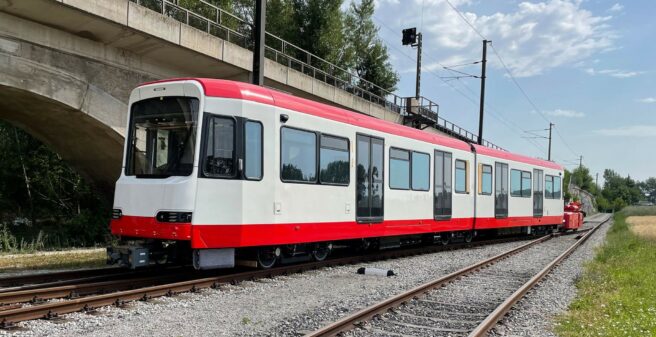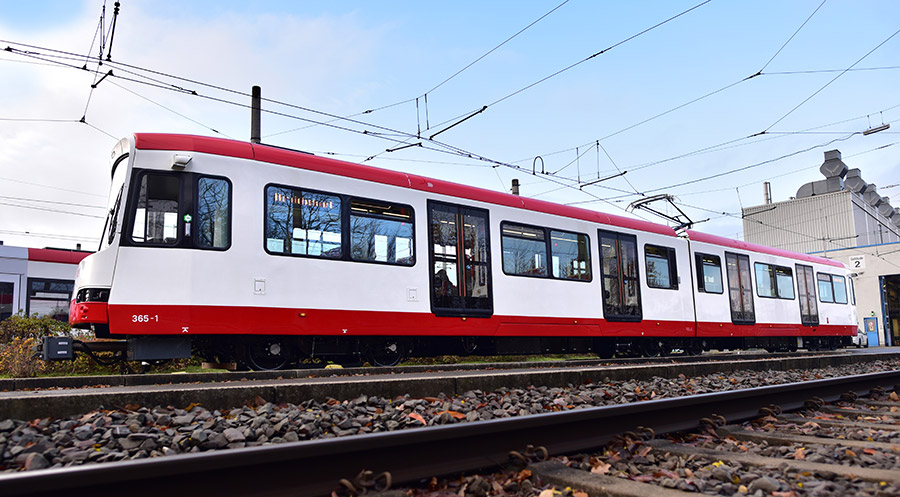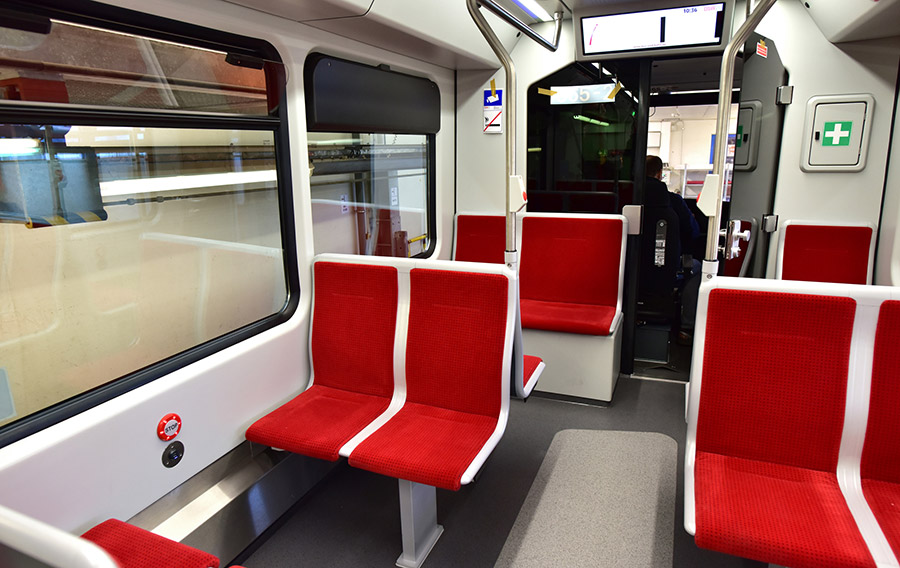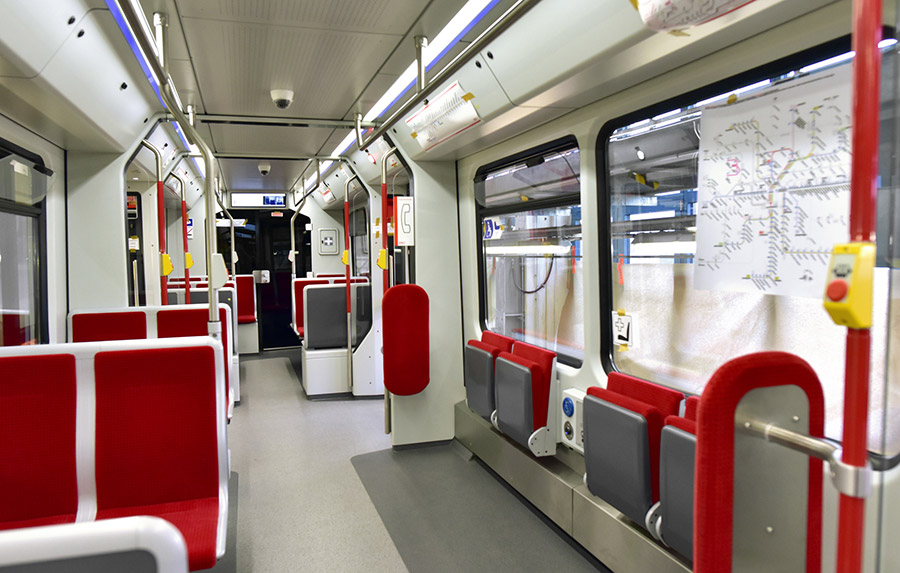
At the beginning of December, a new LRV generation arrived at the DSW21 depot in Dorstfeld. The new Heiterblick-built LRV has a length of 28 m and a weight of 38 t.
Passengers in Dortmund will have to wait until summer 2023 to board the first of a total of 26 new vehicles. But they can already look forward to ultra-modern trains that will be real pioneers in areas such as energy efficiency, accessibility and safety, but also interior design, comfort and passenger information. And that’s not all: in terms of vehicle insulation and lowering, the trams are even unique in Germany and thus role models for the entire local transport industry.

The 26 new and 64 existing high-floor light rail vehicles (B cars), which will be modernised over the next few years in the same design, can boast a variety of other visible and invisible features that will benefit passengers. The aim of the redesign of the Dortmund B80 car fleet is to give the vehicles a uniform, new, contemporary and at the same time timeless appearance. DSW21 passengers will not notice any difference between the modernised or the newly built light rail vehicles. The passenger compartment impresses with clear structuring, supported by light colours that contrast clearly with dark accents and, of course, the classic red of the seats. The two-coloured floor is designed as a kind of path network within the vehicle and marks passage and door areas as well as the seating zones and footwells away from them. The spacious coach sections with their generous footprints offer a pleasant feeling of space.
A video of the new vehicles is available here:
The vehicles feature the following technical highlights:
Kneeling: Bowing for more accessibility
What is new is that DSW21 will be the first transport company in Germany to introduce trams with air pressure kneeling into the route network. On request, the new trams can lower their knees by 3 cm – similar to what is known from buses. Together with structural measures, this “kneeling” ensures that the height difference to the platform is only a maximum of 5 cm in the entire network. This is a decisive improvement in accessibility for people with limited mobility, such as people with walking difficulties or wheelchair users. But passengers with prams or walkers also benefit from this.
Insulation: Quantum leap for more energy efficiency
DSW21 is breaking new ground in energy efficiency by providing the trams with insulation that is unique in Germany. Tests in an air-conditioning duct, which were passed with top marks, certify that the vehicle has top values when it comes to heating and energy: for example, the installed heating power is reduced by more than 70 % from 100 kW to just 27 kW, without the passengers noticing. This is because the cars can be heated more effectively in the cold season – in summer, conversely, they heat up less quickly. The electricity consumption of the entire high-floor fleet is reduced by a total of around 4.8 million kWh per year, which corresponds to the consumption of more than 1,000 four-person households.
The light rail fleet, consisting of a total of 121 high and low-floor trams, has been climate-friendly for many years because it runs on 100% DEW21 green electricity. With the new vehicles, however, DSW21 is making a quantum leap in its eco-balance on several levels, emphasises Ralf Habbes, Technical Authorised Signatory and Operations Manager at DSW21: “The energy consumption for traction current and electricity for heating will be reduced by around 12.5 % calculated for the entire fleet. At current prices, this results in annual savings of around one million euros.”

Door traffic light: green light for boarding
The new vehicles have a “door traffic light” with eye-catching LED lighting. Green signals: Passengers can get on and off in a relaxed manner, flashing light means: the closing process is starting. Red means the doors are closed: The train is ready to depart. This is intended to reduce dangerous situations that can arise in the future due to attempts to board closing doors.
Cameras and sensors: More safety in blind spots
Ultrasonic sensors on the vehicle heads illuminate blind spots on the new tracks. At the rear, the sensors and cameras monitor the coupling area and the space between the cars. The drivers receive the camera images on a monitor. Especially in poor visibility, for example in the evening or during the dark season, this is an effective protection against accidents.
Larger special use areas: More space for wheelchair and co.
Wheelchairs, walkers or prams take up space and have to stand safely in the train. The special use areas are significantly larger in the new carriages and immediately accessible from all doors. This improvement benefits passengers with limited mobility in particular, but all those travelling with prams, luggage or bicycles, for example, now also have more space. This improvement, like other accessibility measures such as optimised push buttons and high-contrast handle bars, was coordinated with the Disability Policy Network (BPN) of the City of Dortmund.

Modern seats: wishes from seat test taken into account
Around 1,100 passengers took part in a large-scale seat test at the beginning of 2019 and voted on what the new seats should be like: Rather thick or rather thinner upholstery? Fabric or imitation leather? Normal or high backrest? The passengers’ wishes – a noticeable upholstery, a fabric cover and a slightly higher backrest – were taken into account when ordering the total of around 5,000 seats for the new trains to be modernised.
Appealing passenger compartment: comfort, service and infotainment
The interior of the trains has been completely redesigned and offers an inviting environment with appealing materials. These include an ambient lighting concept, colour-contrasting floors and a modern infotainment and passenger system. Want to surf the internet and quickly charge your mobile phone during the journey? W-LAN and USB sockets are standard equipment in the new and modernised trains.
The B-car project: Here’s what’s next
“The B-car project is one of the largest investments in the history of DSW21,” emphasises Transport Director Hubert Jung. “As far as I know, there has never been a tender and order for 26 new light rail vehicles and 64 light rail vehicles to be modernised in the same way in our industry. However, the project is not only worth at least €210 million to us, it has kept many areas of our company busy for years, from technology to purchasing, and will continue to do so. That is why we are very proud to have reached another important milestone with the delivery of the first wagon in Dortmund.” Hubert Jung, who is retiring on 31 December, is thus handing over this project for the future to his successor Ulrich Jaeger, who will succeed him as Chief Transport Officer from 1 January 2023.
02.02.2023
